Inaugural Multirotor Challenge 2013
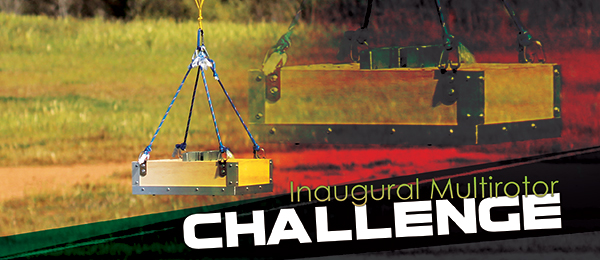
Written and video by Mike Heer. Innov8tive Designs hosts pilots, designers, and inventors in California. As featured on page 21 in the July 2013 issue of Model Aviation and the app.
The inaugural Multirotor Challenge was held in Fallbrook, California, the weekend of March 23-24. The site for this event was the Palomar Fliers’ flying field, located just off of I-15, roughly an hour from downtown San Diego. It is a nice flying field and the Palomar Fliers were wonderful and gracious hosts. They went out of their way to make all of us feel welcome. The event organizers were Lucien Miller and his team from lnnov8tive Designs. Lucian introduced his team members, discussed their responsibilities, and thanked them for their hard work in preparation for and during the event. A number of vendors and supporters donated to the event and the raffle boasted more than $10,000 worth of items for the pilots to win. Items including complete multirotor kits and all of the related goodies were up for grabs. I registered and was one of 63 pilots who attended.

The pilots lined up on the runway for a picture at the first Multirotor Challenge.
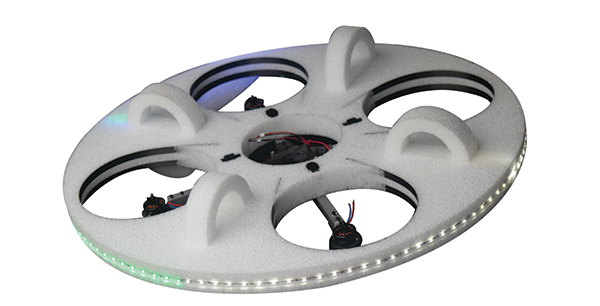
DWFoamies created a new design for this event: a foam flying saucer complete with LEDs.
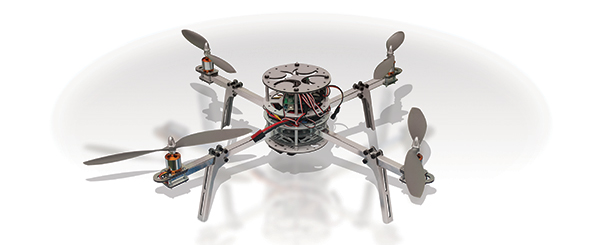
The Cyclone is an AeroQuad kit. The arms are made from towel bars.

Several offerings were on display including two Next Level multirotors from Innov8tive Designs.
Saturday morning started out overcast with a high cloud cover that burned off by mid-morning. A southwesterly breeze built throughout the day and it became a factor in the early afternoon Pylon competition, but was not an issue for the general flying. Saturday was slated for open flying all day with the exception of the noontime demonstrations. While many pilots took advantage of the open flying, the Roswell Flight Test Crew that flew down from Portland, Oregon, remained busy videotaping the event from the sky. The Roswell group posted a fun video of the event on YouTube that covers part of their adventure and offers some nice aerial shots. You can find the link listed in the “Sources” section at the end of the article. Lifting competitions were Saturday’s first two challenges, featuring a Dead Lift event and a Controlled Lift competition. In the dead lift, the multirotor had to lift the weight load selected by the pilot from the ground to at least 5 feet, hold it there for 10 seconds, and then make a controlled landing. The Controlled Lift involved the multirotor lifting the weight and then flying a controlled Figure 8 with the load and finishing with a controlled landing at the starting point. Both events had awards for the heaviest load lifted, regardless of the weight of the multirotor itself. In this competition battery weight counted as payload. The second prize was for the heaviest weight lifted with the battery counting as part of the multiroter’s weight. Although the larger aircraft used a special box with compartments for weights supplied by Lucien and were tied to the multirotor, some contestants, including Ben Berry, added battery packs onto their multirotor to increase the weight. Ben flew a self-designed Micro Spider to win this part of the competition. Blue Sky RC sells the kit for this unit made with 1/8-inch plywood. The company calls it the xRotor Spider Quad. The arms are the same size as the fuselage of a Slow Stick airplane and Ben’s were made of wood, but metal can also be used. It was a fun competition as pilots tried to lift as much weight as they could and most eventually found the point where they couldn’t lift off. Some tipped when trying to lift heavier loads, resulting in broken propellers. Pilot demonstrations were performed during lunch on Saturday and three demonstrations stood out in my mind. One pilot had his multirotor fly an autonomous, programmed flight. He moved the throttle up and then took his hands off of the transmitter, and the multirotor lifted off and flew a complete flight, including a good climb, several maneuvers, and a Figure 8 before coming back and landing close to the takeoff point. The flight was completely autonomous after the initial throttle up by the pilot. It was an impressive demonstration, and especially remarkable to some of the spectators who didn’t realize this was possible with “hobby-size” multirotors. The second demonstration that impressed me was hand-launching a multirotor with propellers that were already spinning to demonstrate how its stabilization system worked to bring the aircraft quickly into a controlled hover. Ben Berry’s Spider multirotors were equipped with ESCs that could change direction, which made for some impressive moves. He flew more aggressively than many of the other pilots. ROC Battery sponsored an award that pilots and spectators decided by vote and Ben’s flying won. Saturday afternoon had two more competitions. The first was the Pylon race. As noted, there was a good breeze in the early afternoon and this helped confirm that multirotors are not designed for Pylon racing. Many made wide turns when flying with the wind and had trouble turning back into the wind. It seemed that the faster they flew, wider the turns were. One pilot tried to race with a little micro multirotor. He couldn’t overcome the wind and landed in “The Jungle,” an overgrown ravine at the edge of the field. Fortunately, the little aircraft was found in working condition. Walt Ferar competed in several events. He did a nice job flying his aircraft in the Pylon competition. He told me that he was an experienced RC Pylon competitor, which showed in his racing. Pilots need to practice for this event, in both calm and windy conditions, to learn how best to fly their multirotors around the pylons in a fast, tight pattern. I expect much improvement by pilots who return to compete next year. Autonomous Spot Landing involved flying the multirotors up and out as directed by Lucien and then activating the aircraft’s return-to-home button so it would return on its own without pilot control. The winner was Jim
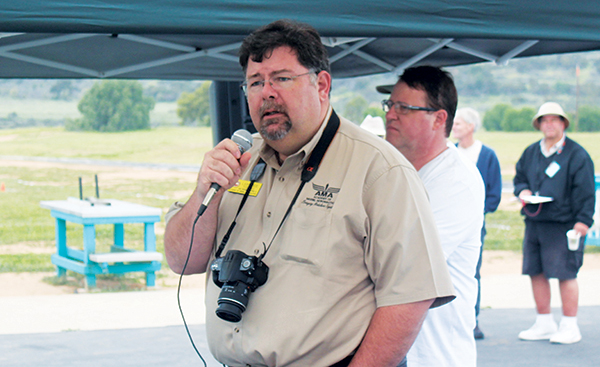
Lawrence Tougas, AMA District X vice president, addressed the crowd. Lucian Miller, the event organizer, is standing in the background.
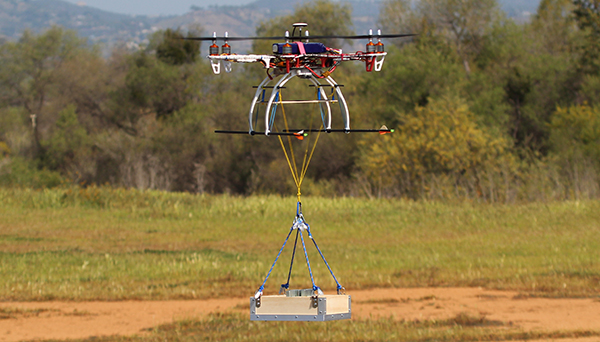
The lift competition utilized a special box that had custom compartments to hold weights.
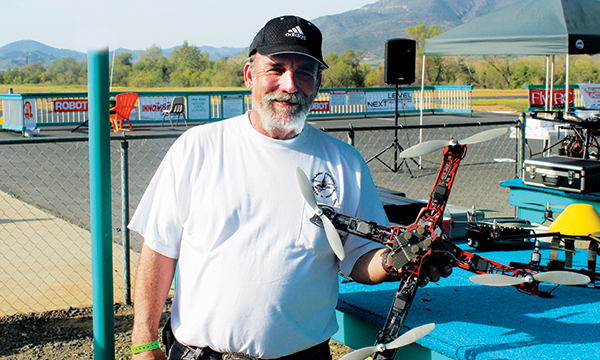
Walt Ferar’s RC Pylon racing experience was evident in the competition. He is shown with the multirotor craft he flew in the Pylon competition.
I had to leave for home at 5 p.m. and missed the Occupy the Sky event above the runway that featured a large number of multirotors flying together. Clips of this are included in the Roswell Flight Test Crew video.
After dinner, the pilots returned to the field for some night flying. A video of the night flying was projected on the side of a trailer at the field. It turned out to be a full day of flying, with plenty to observe and buy from the vendors. I was impressed by the custom carrying cases from Go Professional Cases, Inc. from San Diego. The company can cut to individual requirements and offered standard cases cut for the DJI Phantom. DWFoamies attended and brought a special foam UFO, complete with lights, which can protect a quadcopter and look good in doing so. I bought various parts and propellers from Innov8tive Designs. I also enjoyed seeing a number of the various designs available for purchase, including one made with towel bars for arms from AeroQuad. Sunday featured the Obstacle Course competition, where pilots flew above, around, and under PVC pipes that were set up to form the obstacle course. Flying the course was hard for some and flying it fast was a challenge for many that led to some broken propellers.
More open flying, the spectacular pilots’ raffle, and the presentation of handsomely carved glass awards ended the event on Sunday. Lucien Miller, and his entire staff did a great job of organizing and running the event with the Palomar Fliers. The inaugural Multirotor Challenge was enjoyed by the pilots who attended and they are already looking forward to coming back for Multirotor Challenge 2014! -Michael Heer Sources: Multirotor Challenge website www.innov8tivedesigns.com/MR Roswell Flight Test Crew http://youtu.be/MYpJKFwWv5s










3 comments
Autonomous Landing winner.
edit
correction
Add new comment